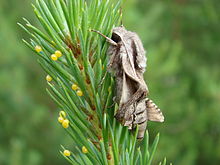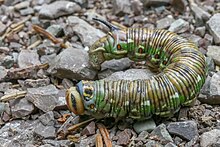Pine hawks
| Pine hawks | ||||||||||||
|---|---|---|---|---|---|---|---|---|---|---|---|---|

Pine hawk ( Sphinx pinastri ) |
||||||||||||
| Systematics | ||||||||||||
|
||||||||||||
| Scientific name | ||||||||||||
| Sphinx pinastri | ||||||||||||
| Linnaeus , 1758 |
The pine hawkmoth or fir arrow ( Sphinx pinastri ) is a butterfly ( moth ) from the family of the swarmers (Sphingidae). He is one of the most common representatives of the family in Central Europe. The species bears its German name because of the host plants. In south-western Europe the species is increasingly being displaced by the closely related species Sphinx maurorum .
features
butterfly
The moths reach a wingspan of 70 to 96 millimeters. The fairly uniform basic color of the trunk and the wings varies between dark brown and cream, but mostly the animals are colored in different shades of gray. Between the thirds of the wing, more or less clearly recognizable, dark brown bands run, which are mostly brightly colored near the forewing edge. In extreme cases, these two bands can either be absent or so pronounced that they are wide and continuous. Between the two bands in the middle of the forewings there are three characteristic, short, dark longitudinal lines. The hind wings are colored brownish gray, the base is a little lighter colored. A broad dark band runs along the sides of the thorax . The abdomen bears a fine dark longitudinal line in the middle and each segment is colored light in front and dark in the back.
Caterpillars
The caterpillars are 75 to 80 millimeters long. After hatching, they are about five millimeters long and yellow in color. Their proportionally large head is brown, the anal horn is dark and split at the end. With increasing age, the body color gradually turns green, after the first moult the green body has six cream-colored-light yellow colored longitudinal lines. The head is then a little lighter green than the body and has two dark stripes arranged at an angle. Later, the longitudinal lines become wider, and both the anal horn and legs acquire a reddish tint.
When fully grown, the caterpillars are either green and have a broad brown-colored back and three white or cream-colored longitudinal lines on each side of the body, which are more or less dissolved into spots, or the body is predominantly brown in color and also has cream-colored spots on the sides. The anal horn is dark in color at this stage. In both color variants, the body is wrinkled with closely spaced, slightly recessed, dark transverse rings. Shortly before pupation, the body color darkens and acquires an oily shimmering sheen.
Similar species
The species cannot be confused with any other hawk species within its range, only very rare color variants of the privet hawk ( Sphinx ligustri ) show a certain similarity. The similar Sphinx maurorum displaces the species in south-western Europe and forms hybrids in the overlapping areas in France. Sphinx maurorum was previously thought to be a subspecies of S. pinastri , but the males have genitals of significantly different shapes. Otherwise, the first generation of S. maurorum cannot be distinguished externally from the pine hawk, the second generation is often much paler in color.
To the east of the range of the pine hawkmoth, Sphinx morio is similar. This species was previously treated as a subspecies of the pine hawk, but the males also have clearly differently developed genitals. Very similar and closely related species are also the hawkers Sphinx caligineus and Sphinx oberthueri that occur in China .
Occurrence
The animals are found in large parts of Europe , east across Asia Minor and the Caucasus , Lebanon and northern Israel to western Siberia . They are absent on the Iberian Peninsula , in the center and north of the British Isles, and in the north of Scandinavia and Russia . On the Iberian Peninsula and in southwest France, the species was increasingly displaced by Sphinx maurorum towards the end of the millennium , so that S. pinastri is now only found in the north and east of France. In the area of overlap, such as around Toulon, there are hybrids between the two species.
The pine hawk is also known from several finds from the Canadian Rockies and the eastern United States , although it is unclear whether these populations are relics of an original settlement in North America or whether these animals were introduced.
The moths colonize open and mixed pine forests , especially in dry heather and steppe areas as well as coniferous forests up to a height of about 1600 meters in the Alps and about 2000 meters in Lebanon . The species is also found in mixed forests, parks and gardens.
Way of life
During the day, sit nocturnal imagines usually awarded camouflaged on the trunks of older pines. Females often do not move away from the nearest trunk after hatching, which is why mating often takes place there. This takes place at night and can last into the morning; the couple then remain connected to the trunk until the next dusk. The couples rarely separate in the afternoon. Then the males go in search of food or in search of other partners. The already fertilized females begin to lay eggs. The nectar plants flown to include many strongly scented plants, such as honeysuckles ( Lonicera ) or soap herbs ( Saponaria ). Both males and females are attracted by artificial light sources. The former are active in Central Europe between about 11:40 p.m. and 2:50 a.m., the females are found a little earlier, from 11 p.m. to 1:10 a.m.
Flight and caterpillar times
The moths fly in the northern areas of the range, such as in Central Europe and also in Siberia, in one generation from May to July. Further south, but also in other areas with less warmth, two generations fly in May and June and again in August, whereby the latter generation sometimes remains incomplete. The caterpillars are found in Central Europe from July to September, in areas with two generations in June and July and in September and October.
Food of the caterpillars
The caterpillars feed on various types of pine ( Pinus ), in particular the Scots pine ( Pinus sylvestris ) and spruce ( Picea ). In the Alpine region , the common spruce ( Picea abies ) is the most important food plant, in Siberia the Siberian spruce ( Picea obovata ). Occasionally caterpillars are also found on the European larch ( Larix decidua ) in northern and central Europe, and cedars ( Cedrus ) are also eaten in southern Europe . The Douglas fir ( Pseudotsuga menziesii ) from North America is also one of the occasional food plants.
development
The females lay about 100 eggs individually close together on the needles of young shoots high up on the food plants. Individual trees or trees that grow in small, isolated groups are usually preferred. The eggs are 2.0 by 1.5 millimeters in size, slightly flattened in the longitudinal axis and initially have a dull yellow color, which later changes to reddish yellow. Before hatching, the caterpillar's dark head can be seen through the egg shell. At 19 to 22 ° C the animals hatch after six to nine days, at lower temperatures after up to 20 days.
First, the caterpillar eats part of the egg shell before using the needles of the trees as food. It sits along a single needle and initially only eats the surface. Later, as the size increases, a needle is held between the legs and eaten from the tip down. Older needles are preferred. Their coloring gives them a good camouflage between the needles, but they are easy to find high up on the plants due to the characteristic eroded shoots. The caterpillars eat during the day and are very sluggish in their behavior. They only move just as much as necessary and also eat relatively little food until they are fully grown. Only then do they become very active and start looking for a suitable place to pupate at some distance from the food plant. Pupation takes place on the ground under moss or the fallen needles of the food plants. The pupa becomes 35 to 40 millimeters long and has a shiny red-brown color. It is very similar to that of the privet hawk . The animals hibernate pupated, often a second time. Occasionally, there are mass reproductions of the pine hawk, but this has no economic impact, mainly due to the large number of parasitoids.
Hazard and protection
The pine hawkmoth is one of the most common and most widespread hawk species in Central Europe , along with the small wine hawk ( Deilephila porcellus ). Since the populations are independent of external factors such as weather and temperature and are therefore relatively constant, and human intervention in the habitats has little influence, the species is not endangered.
Specialized enemies
Numerous parasitoids from the parasitic wasps (Ichneumonidae), Pteromalidae , caterpillar flies (Tachinidae) and Encyrtidae families are known that develop in pine swarms. The caterpillar fly Phryxe erythrostoma is a specialized parasitoid in which up to 18 larvae develop in a pupa of the pine hawk. Another enemy is the doll core club ( Cordyceps militaris ). These mushrooms grow in the pupae, kill them and then develop their club-shaped and yellow-orange fruiting bodies on the surface of the pupae.
swell
Individual evidence
- ↑ a b Sphingidae of the Western Palaearctic. AR Pittaway, accessed January 29, 2008 .
literature
- Günter Ebert (Ed.): The Butterflies of Baden-Württemberg Volume 4, Moths II (Bombycidae, Endromidae, Lasiocampidae, Lemoniidae, Saturniidae, Sphingidae, Drepanidae, Notodontidae, Dilobidae, Lymantriidae, Ctenuchidae, Nolidae). Ulmer Verlag Stuttgart 1994. ISBN 3-8001-3474-8
- Ian J. Kitching, Jean-Marie Cadiou: Hawkmoths of the World. An Annotated and Illustrated Revisionary Checklist (Lepidoptera: Sphingidae). Cornell University Press, New York 2000, ISBN 0-8014-3734-2
- Manfred Koch : We determine butterflies. Volume 2: Bears, Spinners, Swarmers and Drills in Germany. 2nd, expanded edition. Neumann, Radebeul / Berlin 1964, DNB 452481929 .
- AR Pittaway: The Hawkmoths of the western Palaearctic. Harley Books 1993, ISBN 0-946589-21-6
- Hans-Josef Weidemann, Jochen Köhler: Moths. Weirdos and hawkers. Naturbuch-Verlag, Augsburg 1996, ISBN 3-89440-128-1 .
further reading
- Ronny Steen: Pollination of Platanthera chlorantha (Orchidaceae): new video registration of a hawkmoth (Sphingidae) . In: Nordic Journal of Botany . Volume 30, Issue 5, pages 623–626, October 2012 doi: 10.1111 / j.1756-1051.2012.01574.x








